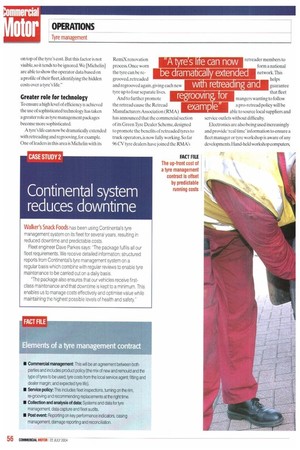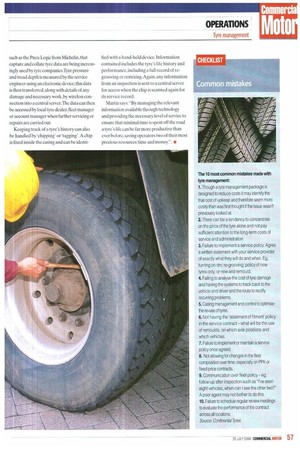IN THE
Page 56

Page 58

Page 59

If you've noticed an error in this article please click here to report it so we can fix it.
GROOVE
Tyre prices getting you down? Want to run your fleet more efficiently? Try a tyre management package, says Julian Milne.
We all know fuel is the main cost for operators and anyone with any sense monitors it with military-like precision to avoid unnecessary expenditure. But even though tyres are generally ranked as the second largest vehicle expense they tend to be seen in a different light.The traditional approach is to only bother with them when they need lobe replaced,and for some this rule still applies. But a new, more professional approach has evolved due to the demands of running large fleets and tyre manufacturers now offer packages with the number-one priority of managing all issues when it comes to keeping those round black things in perfect working order.
From cradle to grave
Wtm Reijmerink, UK Director of commercial tyres for Goodyear, says: The biggest trend in the industry is tyre management. from the cradle to the grave so to speak.This is not surprising as 90% of operations outsource their service requirements in the UK. Operators want good report content and key indicators so they can monitor the performance of their tyres for optimum performance." Commercial tyre contracts have been designed to look at every aspect of tyre upkeep (see panel) and the package can be tailored to meet individual needs. so the operator can maintain tighter control over all tyre and service costs under the contract. The resulting benefits include optimising tyre life, reduction in downtime, predictable and stable costs — and the comforting knowledge that tyres are safe and legal.
Thierry Martin, commercial director of Michelin, believes that if operators are to see the benefits of adopting such a package they need to look further than the initial cost increase: "An operator should not just focus on end price as servicing adds an extra 30%
Bene its inc use t at tyres are le al
on top of the tyre's cost. But this factor is not visible, so it tends to be ignored. We [Michelin] are able to show the operator data based on a profile of their fleet, identifying the hidden costs over a ty, re's life."
Greater role for technology
To ensure a high level of efficiency is achieved the use of sophisticated technology has taken a greater role as tyre management packages become more sophisticated.
A tyre's life can now be dramatically extended with retreading and regrooving, for example. One of leaders in this area is Michelin with its RemiX renovation process. Once worn the tyre can be regrooved, retreaded and regrooved again, giving each new tyre up to four separate lives.
And to further promote the retread cause the Retread Manufacturers Association (RMA) has announced that the commercial section of its Green Tyre Dealer Seheme,designed to promote the benefits of retreaded tyres to truck operators, is now fully working. So far 96 CV tyre dealers have joined the RMA's retreader members to form a national network.This helps guarantee that fleet mangers wanting to follow a pro-retread policy will be able to source local suppliers and service outlets without difficulty.
Electronics are also being used increasingly and provide 'real time' information to ensure a fleet manager or tyre workshop is aware of any developments. Hand-held workshop computers, such as the Pneu Logic from Michelin, that capture and collate tyre data are being increasingly used by tyre companies.Tyre pressure and tread depth is measured by the service engineer using an electronic device; this data is then transferred, along with details of any damage and necessary work, by wireless connection into a central server.The data can then be accessed by local tyre dealer, fleet manager or account manager when further servicing or repairs are carried out.
Keeping track of a tyre's history can also be handled by 'chipping' or 'tagging'. A chip is fixed inside the casing and can be identi fied with a hand-held device. Information contained includes the tyre's life history and performance, including a full record of regrooving or remixing.Again, any information from an inspection is sent to a central server for access when the chip is scanned again for its service record.
Martin says: "By managing the relevant information available through technology and providing the necessary level of service to ensure that minimal time is spent off the road a tyre's life can be far more productive than ever before, saving operators two of their most precious resources: time and money.". •






























































































































































































